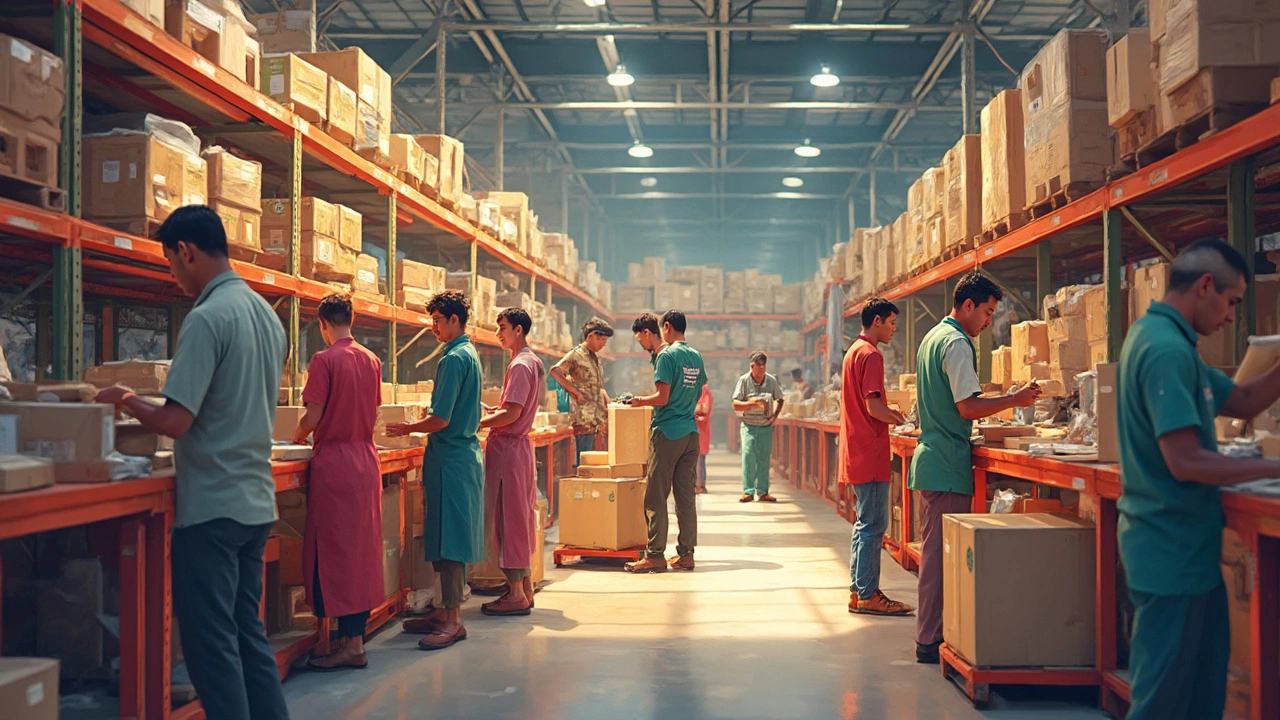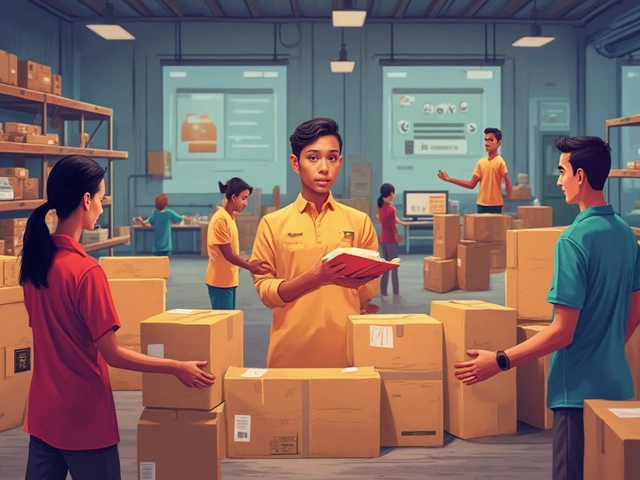You might think e-commerce and dropshipping are the same, but they aren't quite identical twins. Sure, both involve selling stuff online, but the way they go about it is different. In e-commerce, you've got to deal with inventory and shipping yourself. Imagine having a garage piled high with products you're selling. Sounds like a lot of work, right? That’s because it is! You invest in stock, handle it yourself, and make sure shipping goes smoothly.
Now, dropshipping takes a different route. Here, you don’t own any products. When someone orders from your store, you buy the item from a third-party supplier who ships it directly to the customer. Imagine a middleman—except you're more like a bridge connecting the customer and supplier. This means lower up-front costs since you don’t need to stock up products. Plus, your garage remains blissfully empty!
- Understanding E-Commerce
- What is Dropshipping?
- Handling of Products and Inventory
- Logistics and Shipping
- Costs and Risks Involved
- Choosing the Right Model for You
Understanding E-Commerce
E-commerce is like having a digital storefront where everything happens online. It’s the modern way to sell goods and services to customers all over the world. This business model is all about setting up an online store, showcasing products, and handling transactions without the need for a physical shop. Pretty convenient, huh?
Most e-commerce platforms, such as Shopify, WooCommerce, or BigCommerce, help automate and simplify this process. They allow you to customize your shop's look, manage inventory, and even handle marketing tasks. Sounds like a lot of bang for your buck, doesn’t it?
But what happens behind the scenes is where it gets interesting. Here, you, the business owner, are responsible for keeping the shelves stocked, managing returns, and ensuring orders ship on time. It's like running a well-oiled machine. If you ever run out of stock, you might end up disappointing customers.
Take a look at some must-dos for running a successful e-commerce store:
- Inventory Management: Keep track of what’s selling and what's not to ensure efficient stock levels.
- Customer Service: Build trust by providing quick and helpful responses to inquiries and complaints.
- Marketing: Utilize social media and SEO strategies to attract customers and drive sales.
In 2024, e-commerce sales reached a whopping $5.5 trillion globally, showing just how big this market is. Want a piece of that pie? Ensure you're up to the task by knowing both your products and customers well.
What is Dropshipping?
Dropshipping is like the e-commerce model's laid-back cousin. The fundamental thing you do is sell products online, just like regular e-commerce, but here's the kicker: you never actually handle the products you sell. Sounds odd? Let me explain how it works.
When a customer makes a purchase on your site, you don't have that item sitting on a shelf somewhere. Instead, you turn around and order it from a third-party supplier—often a wholesaler or manufacturer. This supplier then ships the product directly to the customer. You keep the difference between what the customer paid and what you pay the supplier. Simple, right?
One of the best things about dropshipping is the low start-up cost. You don’t need to buy loads of stock ahead of time or rent storage space. This makes it perfect for those who want to dip their toes into the e-commerce waters without committing to a big investment. Plus, it gives you the freedom to offer a wider range of products without major financial risk.
However, it's not all sunshine and rainbows. Since you're not in control of inventory or shipping, you rely heavily on your suppliers. They mess up, you mess up. Also, because the barriers to entry are so low, competition is fierce. You need to find ways to stand out with strong customer service or unique product offers.
According to some data, the global dropshipping market size is expected to grow significantly, given its popularity with entrepreneurs who wish to minimize hassle and maximize flexibility. But remember, while it sounds easy, running a successful dropshipping store requires smart strategy and lots of learning. So, if you're thinking about trying it, make sure you’re ready for the ups and downs!
Handling of Products and Inventory
In the world of e-commerce, managing your own products and inventory is a big deal. It means you're in charge of stocking items, storing them, and then shipping everything out to your customers. Imagine a small business that sells handmade candles. They need space to store raw materials, finished products, and packaging, all neatly organized so orders get out the door without a hitch.
Though this hands-on approach gives you total control over quality and delivery, it's not all sunshine and rainbows. There's significant cost involved. Renting storage space, dealing with unsold stock, and handling shipping mishaps can be tricky and expensive, especially if you get your projections wrong and end up with more wax than orders!
With dropshipping, the inventory game changes entirely. Here, you don’t actually keep the products you sell. When you get an order, the supplier takes care of packaging and shipping it directly to the customer. Let's take an online store selling quirky T-shirts as an example. They can offer hundreds of designs without worrying about buying and storing these T-shirts upfront. No warehouse, no physical space occupied. Your supplier deals with the inventory, freeing you from the logistical headaches.
It sounds perfect, right? But there's always a catch! Since you're relying on suppliers, you have less control over product quality and shipping times. If they mess up, it's your reputation on the line, and that's no small thing in the fierce world of online retail.
Whether it's dealing directly with the inventory or letting someone else handle it, the key is understanding your business needs. Do you want control and are ready to handle the logistics? Or would you take a bit of risk to avoid the hassle of product handling? Each path has its unique challenges and opportunities.

Logistics and Shipping
When it comes to logistics and shipping, e-commerce and dropshipping play on different fields. In a traditional e-commerce model, you're the boss of the whole shipping process. That means you’ve got to keep track of inventory, package the products, and ship them out. It’s like running a mini warehouse, and unless you’ve got a decent system in place, it can get overwhelming fast.
On the flip side, dropshipping shifts the logistics burden to your supplier. You make the sale, they pack and ship. It’s like magic, but real. This means you don’t have to worry about shipping delays or damaged products during transit, as it's the supplier’s responsibility. But, and this is a big 'but', you’ve got less control over delivery times and product quality. Ever ordered something online and it took forever to arrive? That’s one of the challenges.
Many people dig dropshipping for its hands-off approach, but the downside is that messy logistics like inventory mix-ups or shipping snags are out of your hands. Meanwhile, e-commerce allows for deeper quality checks and faster shipping because you oversee the whole process.
You might be wondering about costs. For e-commerce, you need to invest in storage space and sometimes even deal with international shipping complexities. These can pile up. But in dropshipping, while you lose control, you skip those warehouse costs and storage fees.
Fast Fact: Over 40% of online shoppers consider fast shipping essential when deciding to purchase. It’s a big deal in the competition for customers. Perhaps opting for a hybrid model, where you combine e-commerce and dropshipping strategies, might strike the right balance, offering you both control and a streamlined process.
Costs and Risks Involved
Diving into the world of e-commerce and dropshipping, you quickly realize that each has its own set of costs and risks. Let’s break them down.
Starting with e-commerce, costs can pile up quicker than you might expect. You're covering inventory buy-ups, storage space, shipping supplies, and if you're extra fancy, a slick website. All these need some serious cash up-front. The risk here? You might end up with unsold stock, taking up space and sucking up your capital.
On the other side, dropshipping seems enticingly cheap since you don’t have to buy products before you sell them. Sounds like a dream, right? But here's the catch: you trade inventory costs for supplier reliability. You rely heavily on your suppliers to have the items in stock and to handle shipping efficiently. If a supplier messes up, your customer's unhappy. Plus, your profit margins can be slimmer since supplier costs might cut into your share.
So, how do these stacks up against each other? Let's take a closer look:
| Model | Typical Cost | Risk Level |
|---|---|---|
| E-commerce | Inventory, storage, shipping - $$$ | High (e.g., unsold stock) |
| Dropshipping | Minimal startup costs | Medium (e.g., supplier issues) |
This table gives you a snapshot of what you'd be looking at. Summing it up, with e-commerce you invest more upfront but generally get higher profits if managed well. Dropshipping is lower-risk financially at the start, but comes with different challenges like finding reliable suppliers.
In the end, the right choice depends on how much risk you're willing to take and what kind of control you want over your business. Are you okay with navigating supplier hurdles, or would you rather handle products yourself? Think it through and weigh your options carefully!
Choosing the Right Model for You
Alright, so you're ready to jump into the world of online selling, but how do you pick between e-commerce and dropshipping? It all boils down to your goals, resources, and how much control you want over your business.
If you're all about having control and building a brand that customers remember, e-commerce might be your thing. With this model, you get to personalize your products, handle customer service directly, and even manage your shipping times. But remember, this also means you're in charge of maintaining inventory, which can be a headache if you’re just starting out.
On the flip side, if you're tight on cash or want to test different products without the financial hit, then dropshipping could be your best choice. Imagine launching a store without spending a dime on inventory. Sounds dreamy, right? The downside? You’ve got less say over shipping times and quality control because you're relying on suppliers to deliver the goods.
Here’s a quick comparison to see what fits your needs:
- Initial Investment: E-commerce usually requires more upfront cash to stock products, while dropshipping demands very little initial outlay.
- Control: E-commerce lets you manage every aspect of your business, while dropshipping requires you to trust third-party suppliers.
- Inventory Management: You'll need space and strategy to manage inventory in e-commerce. Dropshipping eliminates this hassle completely.
- Risk Level: Dropshipping is generally lower risk since you’re not spending a bundle on unsold inventory.
So, what's the verdict? If you're looking for maximum control and are ready for some heavy lifting, e-commerce might be your sandbox. But if you want to start lean and mean, give dropshipping a whirl. Whatever you choose, make sure it aligns with what you want out of your business journey. It's all about finding that sweet spot between your resources and your ambitions.





